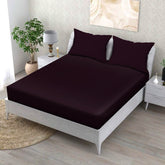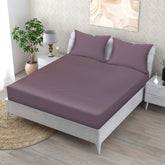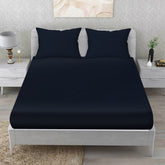Flat Sheets vs. Fitted Sheets: Pros, Cons, and When to Use Each
Ever wrestled with a Flat sheet, trying to get those corners just right? Or perhaps you've marveled at the sheer versatility of a simple flat sheet, using it for everything from a picnic blanket to a makeshift curtain? We've all been there, caught in the age-old debate of flat versus fitted bed sheets. A fitted sheet is a sheet with elasticized sides and corners designed to snugly fit over a mattress, while a flat sheet is a rectangular piece of fabric that lies on top of the fitted sheet (or directly on the mattress).
This blog post aims to compare and contrast flat and fitted sheets, exploring their pros and cons, and ultimately helping you decide which type best suits your sleeping needs.
Flat sheets have been a bedding staple for centuries, with their origins tracing back to ancient civilizations. Fitted sheets, a more modern invention, gained popularity in the 20th century as mattresses became thicker and more standardized.
Fitted Sheets: Pros and Cons
Fitted sheets, with their elasticized sides and corners, are designed to hug your mattress snugly. They're the go-to choice for many, and for good reason.
A. Pros:
- Snug fit and stay in place: The elastic ensures a secure fit, preventing the sheet from bunching or slipping.
- Ease of making the bed: Once the corners are in place, the rest is relatively simple.
- Protection of the mattress: Acts as a barrier against spills, dust mites, and general wear and tear.
- Ideal for restless sleepers: Stays put even with significant movement.
- Secure Fit: The elastic keeps the sheet in place, preventing bunching and wrinkling throughout the night. This is especially beneficial for restless sleepers.
- Mattress Protection: They provide a reliable barrier against dust, allergens, and wear and tear.
B. Cons:
- Can be difficult to fold: Mastering the art of folding a fitted sheet is a challenge for many.
- Prone to elastic wear and tear: Over time, the elastic can lose its elasticity.
- Can be difficult to find the correct size: Mattress sizes vary, and not all fitted sheets are created equal.
C. When to use fitted sheets:
- Standard mattresses.
- Children's beds.
- For people who move a lot during sleep.
Flat Sheets: Pros and Cons
A. Pros:
- Versatility (top sheet, extra layer, crafting, etc.): Can be used for a multitude of purposes beyond bedding.
- Easier to fold and store: A simple rectangular shape makes folding and storage a breeze.
- Can be used for various mattress sizes: Offers more flexibility in terms of fit.
- Affordable and readily available: Generally less expensive and easier to find.
B. Cons:
- Can slip and bunch up during sleep: Lacks the secure fit of a fitted sheet.
- Requires more effort to make the bed: Needs to be tucked in neatly.
- Doesn't offer as much mattress protection: Provides a minimal barrier against spills and dust mites.
- Tucking Required: Flat sheets require careful tucking to stay in place, which can be challenging for some.
- Potential for Bunching: Without elastic, they're more prone to bunching and wrinkling during the night.
- Added step: Some people consider the flat sheet an unnecessary step in making a bed.
C. When to use flat sheets:
- As a top sheet in warmer climates.
- For adjustable beds.
- For those who prefer a traditional bedding style.
- For use as a multi-purpose cloth.
- For use with specialty mattresses.
Recap the key points of the comparison: Both flat and fitted sheets have their pros and cons. Fitted sheets offer a snug fit and mattress protection, while flat sheets provide versatility and affordability. The best choice depends on your individual needs, preferences, and sleeping habits.
For premium comfort and a perfect night's sleep, shop 100% cotton fitted bedsheets online with Cotton Snug. Our high-quality, breathable cotton sheets offer a snug fit, durability, and luxurious softness. Browse our collection today for the perfect addition to your bedding!







